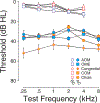Chronic Conductive Hearing Loss Is Associated With Speech Intelligibility Deficits in Patients With Normal Bone Conduction Thresholds
- PMID: 31490800
- PMCID: PMC7056594
- DOI: 10.1097/AUD.0000000000000787
Chronic Conductive Hearing Loss Is Associated With Speech Intelligibility Deficits in Patients With Normal Bone Conduction Thresholds
Abstract
Objectives: The main objective of this study is to determine whether chronic sound deprivation leads to poorer speech discrimination in humans.
Design: We reviewed the audiologic profile of 240 patients presenting normal and symmetrical bone conduction thresholds bilaterally, associated with either an acute or chronic unilateral conductive hearing loss of different etiologies.
Results: Patients with chronic conductive impairment and a moderate, to moderately severe, hearing loss had lower speech recognition scores on the side of the pathology when compared with the healthy side. The degree of impairment was significantly correlated with the speech recognition performance, particularly in patients with a congenital malformation. Speech recognition scores were not significantly altered when the conductive impairment was acute or mild.
Conclusions: This retrospective study shows that chronic conductive hearing loss was associated with speech intelligibility deficits in patients with normal bone conduction thresholds. These results are as predicted by a recent animal study showing that prolonged, adult-onset conductive hearing loss causes cochlear synaptopathy.
Conflict of interest statement
Conflicts of Interest and Source of Funding:
This research was funded by the NIH – NIDCD P50 DC015857 (SFM, Project PI).
Figures







Similar articles
-
Amplification of transcutaneous and percutaneous bone-conduction devices with a test-band in an induced model of conductive hearing loss.Int J Audiol. 2016 Nov;55(11):653-7. doi: 10.1080/14992027.2016.1193234. Epub 2016 Jun 27. Int J Audiol. 2016. PMID: 27347717
-
BAHA in children and adolescents with unilateral or bilateral conductive hearing loss: a study of outcome.Int J Pediatr Otorhinolaryngol. 2007 Jan;71(1):135-45. doi: 10.1016/j.ijporl.2006.09.014. Epub 2006 Nov 7. Int J Pediatr Otorhinolaryngol. 2007. PMID: 17092570
-
Prediction of postoperative speech comprehension with the transcutaneous partially implantable bone conduction hearing system Osia®.HNO. 2024 Jan;72(Suppl 1):1-9. doi: 10.1007/s00106-023-01337-3. Epub 2023 Oct 9. HNO. 2024. PMID: 37812258 Free PMC article.
-
Implantable Devices for Single-Sided Deafness and Conductive or Mixed Hearing Loss: A Health Technology Assessment.Ont Health Technol Assess Ser. 2020 Mar 6;20(1):1-165. eCollection 2020. Ont Health Technol Assess Ser. 2020. PMID: 32194878 Free PMC article.
-
Multicentric study on surgical information and early safety and performance results with the Bonebridge BCI 602: an active transcutaneous bone conduction hearing implant.Eur Arch Otorhinolaryngol. 2023 Apr;280(4):1565-1579. doi: 10.1007/s00405-022-07792-y. Epub 2023 Jan 10. Eur Arch Otorhinolaryngol. 2023. PMID: 36625869 Free PMC article. Review.
Cited by
-
Electrophysiological markers of cochlear function correlate with hearing-in-noise performance among audiometrically normal subjects.J Neurophysiol. 2020 Aug 1;124(2):418-431. doi: 10.1152/jn.00016.2020. Epub 2020 Jul 8. J Neurophysiol. 2020. PMID: 32639924 Free PMC article.
-
Idiopathic Sudden Sensorineural Hearing Loss: Speech Intelligibility Deficits Following Threshold Recovery.Ear Hear. 2021 July/Aug;42(4):782-792. doi: 10.1097/AUD.0000000000000987. Ear Hear. 2021. PMID: 33259444 Free PMC article.
-
Quantitative assessment of cochlear and vestibular ganglion neurons in temporal bones with chronic otitis media.Eur Arch Otorhinolaryngol. 2021 Feb;278(2):331-338. doi: 10.1007/s00405-020-06094-5. Epub 2020 Jun 1. Eur Arch Otorhinolaryngol. 2021. PMID: 32488375 Free PMC article.
-
Envelope following responses predict speech-in-noise performance in normal-hearing listeners.J Neurophysiol. 2021 Apr 1;125(4):1213-1222. doi: 10.1152/jn.00620.2020. Epub 2021 Mar 3. J Neurophysiol. 2021. PMID: 33656936 Free PMC article.
-
The Long-Term Effect of Childhood Otitis Media on Speech-in-Noise Testing at Ages 9 and 13.Laryngoscope Investig Otolaryngol. 2025 Jan 15;10(1):e70077. doi: 10.1002/lio2.70077. eCollection 2025 Feb. Laryngoscope Investig Otolaryngol. 2025. PMID: 39816919 Free PMC article.
References
-
- ANSI (1997). Method for the calculation of the Speech intelligibility index. ANSI S3.79–1997 In Accredited Standards Committee S3, Bioacoustics. New York: Acoustical Society of America (Melville, NY).
-
- Clopton BM, Silverman MS (1977). Plasticity of binaural interaction. II. Critical period and changes in midline response. J Neurophysiol, 40, 1275–1280. - PubMed
-
- Conlee JW, Parks TN, Romero C, Creel DJ (1984). Auditory brainstem anomalies in albino cats: II. Neuronal atrophy in the superior olive. J Comp Neurol, 225, 141–148. - PubMed
-
- Conlee JW, Parks TN, Creel DJ (1986). Reduced neuronal size and dendritic length in the medial superior olivarynucleus of albino rabbits. Brain Res, 363, 28–37. - PubMed
Publication types
MeSH terms
Grants and funding
LinkOut - more resources
Full Text Sources
Medical

